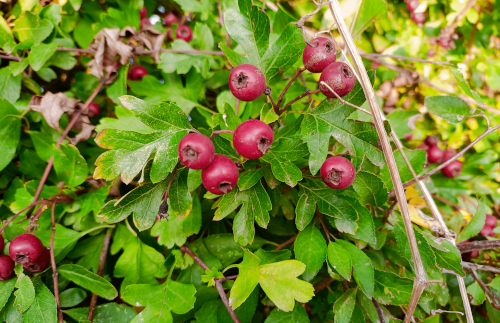Read about this thorny shrub, which may also be known as the Maytree, a Whitethorn, a Mayflower, the Quickthorn, the Thornapple, or even the Hawberry.
Hawthorns
Hawthorns are shrubs native to Europe, the UK, North America and parts of Asia. They are thorny to help protect themselves.
Haws
Haws are often referred to as the berry of the hawthorn tree/shrub. However, haws are actually botanically pomes, not berries.
Haws are small and slightly elongated spherically-shaped fruits, similar in size to a blueberry. They are usually a vivid orange to deep red color but can sometimes become darker shades of red depending on the variety of hawthorn and the location/region where the hawthorn is growing. Haws can have between one and five seeds in each fruit depending on the variety.
Can haws be eaten?
Read on…
The Hawthorn: Nature’s Multi-Faceted Marvel
The botanical world offers a cornucopia of delights, both exotic and common, that are capable of capturing the human imagination. One such versatile and intriguing specimen is the Hawthorn, whose formal botanical name is Crataegus. Hailing from the rose family, Rosaceae, Hawthorns embody a mixture of beauty, utility, and resilience. Their charm lies not just in their aesthetic appeal but also in their multifaceted utility which ranges from medicinal uses to culinary delights.
The Look and Leaves of the Hawthorn
First impressions are indeed lasting, and Hawthorns do not disappoint in this regard. Hawthorns are generally deciduous shrubs or small trees that can grow anywhere from 6 to 40 feet (about 2 to 10 meters) tall. Depending on the species, their bark can range from grey to brown, sometimes replete with furrows and fissures that add an air of antiquity and rustic charm.
When it comes to the leaves of Hawthorns, they are nothing short of a botanist’s dream. Often lobed or serrated, these leaves display a variety of shapes and sizes that can change within the same species depending on environmental factors. Nature, it seems, gifted the Hawthorn with an ever-changing wardrobe, making it a fascinating subject for both casual observers and plant enthusiasts.
Locations and Origins
You could think of the Hawthorn as the globetrotter of the plant kingdom. Originally native to temperate regions of Europe, including the UK, North America, and Asia, Hawthorns have made their way across various geographies. Today, they can be found in meadows, open woodlands, and even in urban settings, proving their adaptability to a wide array of environments.
The Allure of Hawthorn Berries (That are not really berries)
Perhaps one of the most intriguing aspects of Hawthorns is their berries, commonly known as haws. These small, round or oval fruits range in color from red to black, and sometimes even yellow, depending on the species.

Edibility and Culinary Uses
Now, for the question that has probably been burning in the back of your mind: “Can you eat those pretty little berries?” The answer is no and yes. The fruit of hawthorn, usually called haws, can be edible, but are not to be eaten raw. Instead, they can be made into jams or used to make wine. Sometimes they are used as flavour enhancers in beverages such as brandy and rum. Botanically the fruits of a Hawthrorn are pomes (not actually a berry), but they look similar to, and can be mistaken for, berries.
More Than Just a Pretty Face
If the Hawthorn were to attend a social gathering, it would undoubtedly be the life of the party. Not just because it’s pretty to look at, but because it has so many interesting stories and uses to share. For instance, the wood of the Hawthorn is extremely hard and has been traditionally used for carving intricate objects and crafting durable tools.
Moreover, various cultures have imbued this plant with mythological and spiritual significance. In Celtic folklore, the Hawthorn is considered magical and is often associated with the realm of fairies. To cut down a Hawthorn was to invite bad luck, demonstrating the deep cultural respect for this versatile plant.
Fun Facts – Who Doesn’t Love Good Trivia?
1. Historically, hawthorns were considered symbols of hope, with their branches being used in wedding processions. Perhaps, the thorns represented the occasional prickly moments in matrimony, while the beautiful flowers embodied the joyous times!
2. Speaking of flowers, hawthorns come alive with stunning white blossoms during spring, which later pave the way for the vibrant haws.
3. Some species of hawthorns have been used in traditional medicine, believed to have cardiovascular benefits. Remember, though, always to consult with a healthcare professional before embarking on any herbal treatments. Never take any medicines, including herbal medicines, without being sure of what you are taking and seeking appropriate professional advice first. Just because something grows, it does not mean that it is safe.
Conclusion
In the end, Hawthorns are more than just another plant or shrub. They are a blend of beauty, utility, and adaptability. Whether it’s the captivating shape of their leaves, the geographic diversity of their habitats, or the nutritious allure of their berries, hawthorn berries or haws add a unique flavor to the botanical world.
So the next time you pass by a Hawthorn, give it a nod of appreciation. After all, how many plants do you know that can boast being a culinary ingredient, a heart-healthy supplement, a woodworking material, and a mythical entity, all rolled into one? If plants had resumes, the Hawthorn’s would be several pages long, and every page would be utterly fascinating. Hopefully, this article on About Plants has done it justice. Something wrong or missing? Get in touch.